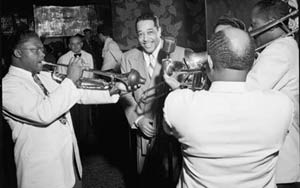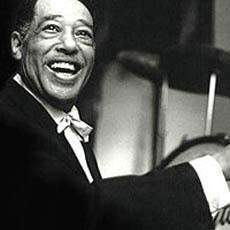|
 Duke Ellington and some of his musical friends at the Aquarium in New York, 1946. |
RAY FREEMAN: And I'm Ray Freeman with the VOA Special English program PEOPLE IN AMERICA. Every week we tell about a person who was important in the history of the United States. Today, we tell about the great jazz musician, Edward Kennedy Ellington. He was better known to the world as "Duke" Ellington.
(MUSIC)
SHIRLEY GRIFFITH: That was Duke Ellington's orchestra playing "Take the 'A' Train." Just the first few notes of that song are enough to tell any music expert who is playing. It is like a musical sign. The sign says, "Listen! You are about to hear something by Duke Ellington's orchestra." It was always the first song his orchestra played.
"Take the 'A' Train" was only one of hundreds of songs he played all over the world.
(MUSIC)
RAY FREEMAN: Edward Kennedy Ellington was born on April 29th, 1899, in Washington, D.C. His family lived in the African-American area of Washington. It was a time when racial separation was the law in much of the United States. Racial laws and racial hatred were to follow Edward Kennedy Ellington all through his life.
|
 A friend once called him "Duke" because he liked clothes so much, like a member of a royal family |
Other friends laughed. Yet they all began calling him "Duke." The name stayed with him the rest of his life.
SHIRLEY GRIFFITH: When he was about seven years old, Duke Ellington began to play the piano. When he was in high school, he began to paint. He became very good at both.
A famous art school in New York City invited him to take classes there. But he had already decided to become a musician. He got his first professional job in 1916. He played music at night and painted business signs during the day.
The most popular music back then was called ragtime. Duke listened to ragtime piano players who visited Washington. Then he tried to play as well or better than they did. Years later, he recorded a song that showed how well he could play the piano. It is a ragtime song called "Lots o' Fingers."
(MUSIC)
RAY FREEMAN: Duke Ellington moved to New York City in 1923. He had a small band. Soon it was playing at the famous Cotton Club, where it would play for many years. Duke and his band could play at the Cotton Club. But they could not come to hear anyone else, because they were black.
Duke did not become angry. He did not become filled with hatred toward white people. He let his music speak for him.
|
 "Take the 'A' Train" was Duke Ellington's most famous song. |
At the same time, Duke Ellington and the members of his orchestra began recording their songs. Their first hit record was one of their most famous. It was recorded in October of 1930. It was called "Dreamy Blues." Later, Duke changed the name. It is still considered a great blues song and is often played today. It is called "Mood Indigo."
(MUSIC)
RAY FREEMAN: An orchestra is a team made up of individual players. Like any team, the individuals in an orchestra must cooperate to produce good music. The leader of a team, or an orchestra, must learn the strength and the weakness of each member. And a good leader will use this knowledge to make the team or orchestra produce the best result.
In the 1920s and 1930s, members of a dance orchestra never stayed with one group for long. Musicians moved from group to group. Yet, when a musician played with Duke Ellington, he usually stayed, sometimes for many years.
SHIRLEY GRIFFITH: This had an effect on the group's music. Duke would write music especially for musicians in the orchestra. His songs used the strengths of one or two individuals. The rest of the orchestra cooperated with them.
|
 Duke Ellington often played the Paramount Theater in New York City |
RAY FREEMAN: Some members of the Duke Ellington orchestra were the best jazz musicians of their day. Their cooperation produced a sound that is almost impossible for others to re-create. To create that same sound, you would need the musicians who first played the music.
One of those musicians was "Cootie" Williams. He played the trumpet in the Duke Ellington orchestra for many years. Duke Ellington used the strength of Cootie Williams when he wrote a song called, "A Concerto for Cootie." Critics said this work showed the unity between the music writer, the leader of the orchestra, and its members.
Listen as Cootie Williams seems to lead the orchestra. Hear how the other members cooperate with him to produce a very beautiful and special sound.
(MUSIC)
SHIRLEY GRIFFITH: This Special English program was written by Paul Thompson. It was produced by Lawan Davis. I'm Shirley Griffith.
RAY FREEMAN: And I'm Ray Freeman. Join us again next week at this time for the second part of our PEOPLE IN AMERICA program about Duke Ellington on the Voice of America.
Jacob Riis, 1849-1914: he worked to make New York city a better place for poor people
Winslow Homer, 1836-1910: America's greatest painter of the 19th century
Woody Guthrie wrote one of America’s best loved songs
Jackson Pollock, 1912-1956: he invented a new kind of painting
(来源:VOA 编辑:陈丹妮)
